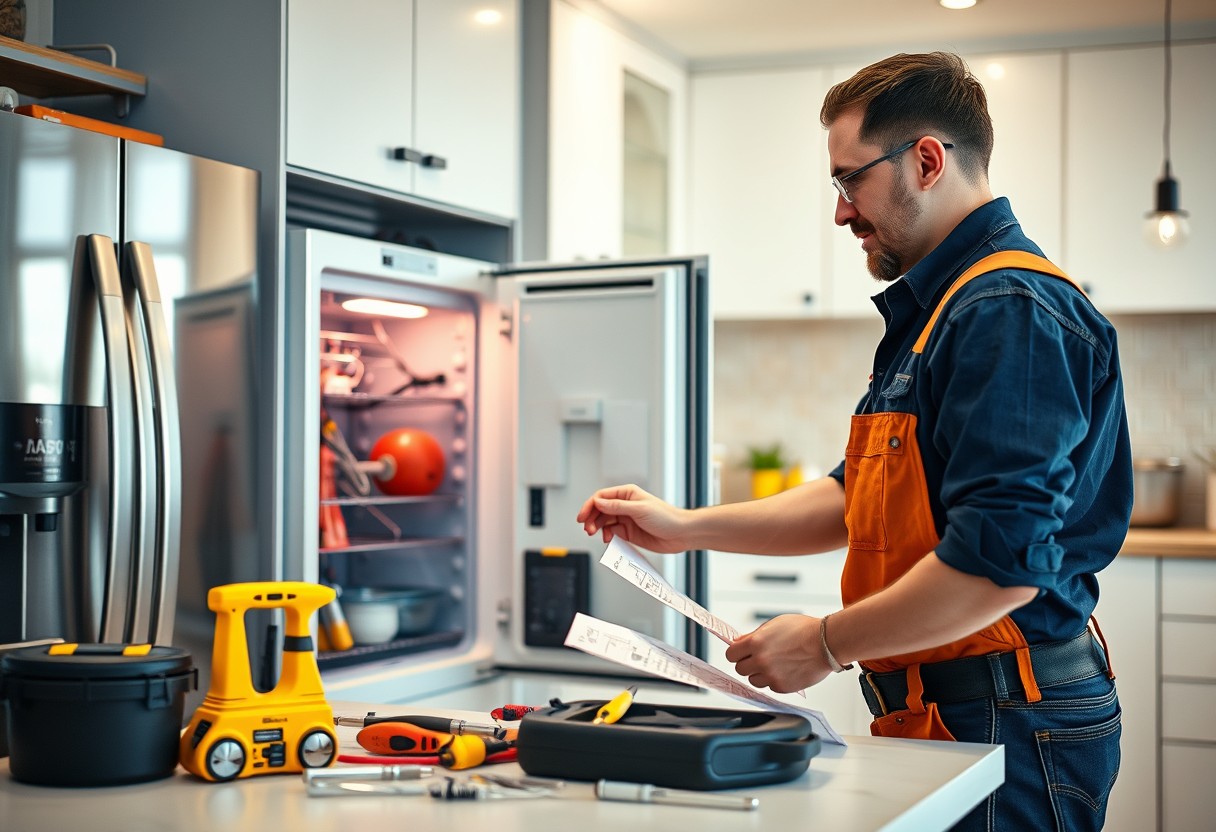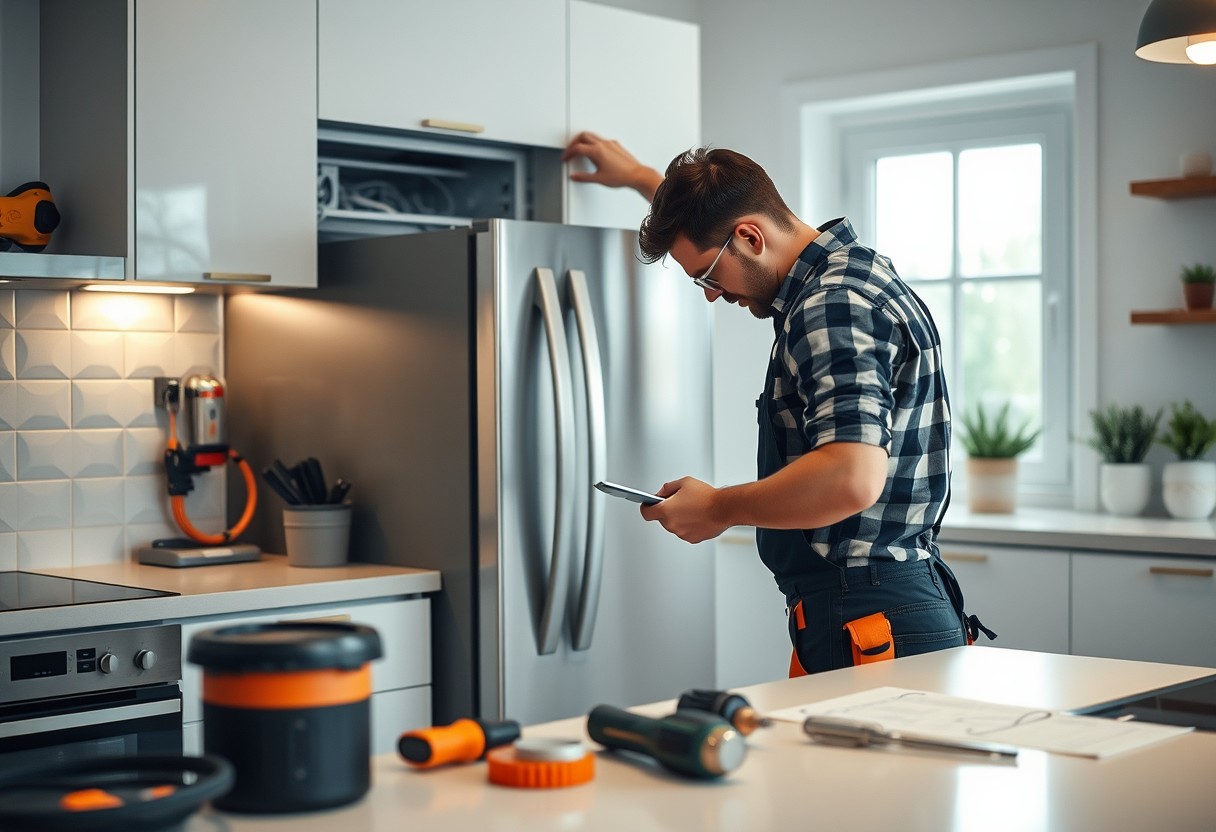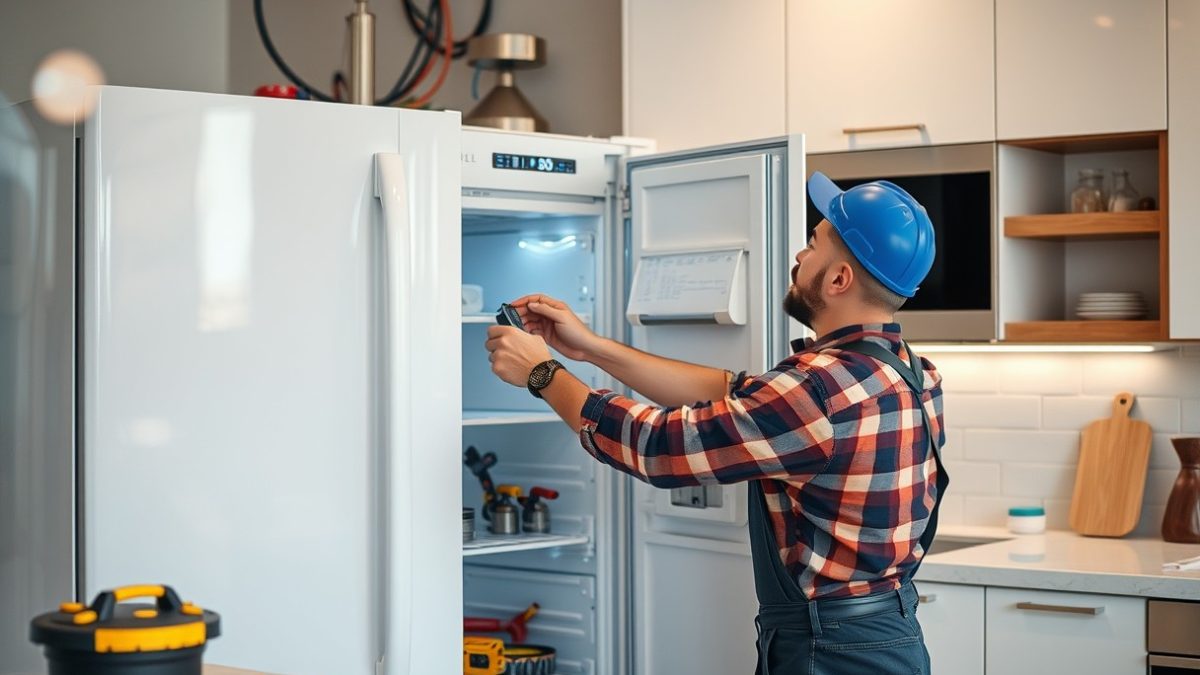
Why Is An Integrated Manufacturer Warranty Program Essential For Retail Success?
September 6, 2024
How Do Gas Appliance Installations Elevate Home Efficiency And Safety?
September 10, 2024Expertise in electrical appliance installations is crucial for ensuring a safe and efficient setup in your home. You must understand that proper installation not only enhances the performance of your devices but also reduces the risks of electrical hazards, such as fires or shock. This blog post will unveil the key secrets that can help you achieve a seamless installation process, including vital safety precautions, tools you should have on hand, and expert tips for troubleshooting common issues. By following these insights, you can enjoy the peace of mind that comes with a job well done.
Key Takeaways:
- Proper Planning: Thoroughly assess the installation site and understand the appliance specifications to ensure compatibility and safety.
- Professional Assistance: Engaging certified electricians can prevent common installation issues and ensure adherence to local electrical codes.
- Post-Installation Checks: Conducting a series of tests after installation can confirm that the appliance operates efficiently and safely.

Understanding Electrical Appliance Installations
A seamless electrical appliance installation is critical for ensuring the smooth operation and longevity of your devices. Without a proper understanding of the installation process, you run the risk of functionality issues, operational hazards, and even damage to your home’s electrical infrastructure. To ensure a successful installation, you need to appreciate the steps involved, the common types of appliances, and the safety standards you must adhere to. Knowing these factors not only enhances your appliance’s efficiency but also provides peace of mind regarding safety and reliability.
Importance of Proper Installation
Installation of electrical appliances is not just a mere process; it is an imperative step that guarantees your appliances perform optimally and safely. When installed correctly, your devices can function without interruptions, minimizing unnecessary energy consumption. Improper installation, on the other hand, can lead to malfunctions, increased utility bills, and partially functional appliances that could fail at crucial moments.
Moreover, a proper installation also safeguards against potential accidents, such as electrical fires or shocks. Knowing that your devices were set up correctly allows you to use them without constant worry about safety issues. It’s crucial to consider hiring a qualified professional for installations if you’re not well-versed in electrical work.
Common Types of Electrical Appliances
For residential settings, understanding the various types of electrical appliances can significantly assist you in making informed decisions. Some common types of appliances include:
| Kitchen Appliances | Ovens, refrigerators, microwaves, dishwashers. |
| Cleaning Appliances | Vacuum cleaners, washing machines, dryers. |
| Heating and Cooling Devices | Air conditioners, heaters, fans. |
| Entertainment Systems | Televisions, audio systems, gaming consoles. |
| Personal Care Devices | Hairdryers, electric shavers, toothbrushes. |
Recognizing the different types of appliances you may encounter can aid in choosing the right ones for your needs and understanding their specific installation requirements. Each type of appliance often comes with distinct installation guidelines that must be closely followed for optimal performance.
Safety Standards and Regulations
An important aspect of electrical appliance installations is adhering to established safety standards and regulations. Different regions may have unique codes that govern how electrical work should be carried out to prevent accidents. These standards typically cover aspects such as the electrical load capacity, grounding methods, and the use of proper circuit breakers, ensuring that your appliances operate safely without causing hazards in your home.
In addition to local building codes, certain appliances may have their own safety guidelines provided by the manufacturer. Following these guidelines is imperative to prevent mishaps and protect your investment in these devices.
Safety regulations are vital for ensuring a secure environment when using your appliances. Ensuring your installations comply with local laws and manufacturer guidelines greatly reduces the risk of fire hazards, shock hazards, and appliance losses. Not following these regulations can lead to legal consequences or even serious accidents.
Safety also includes regularly checking and maintaining your installed appliances to identify any potential risks early. Prioritize these aspects, and you will contribute to a safer living space while maximizing the lifespan of your appliances.
The Planning Phase
Little do many understand, but the planning phase of electrical appliance installation lays the very foundation for a seamless process. This phase entails a detailed examination of various factors that will ultimately influence the success of the installation. Taking the time to assess your specific needs and the specifications of the appliance can save you countless headaches down the road. Trusting the right approach during this stage allows you to make informed decisions that set the stage for a successful and effective installation.
Evaluating Installation Requirements
For any successful installation, you must first evaluate the installation requirements of your electrical appliance. This includes understanding the manufacturer’s specifications, local electrical codes, and any special considerations related to your unique home layout. Assessing factors like voltage, amperage, and available electrical outlets will guide you toward choosing the correct appliances and the best method for installation.
Additionally, it’s necessary to consider your existing electrical system’s capability to handle the new appliance. You need to determine if upgrades to your electrical panel or wiring are necessary. Neglecting this evaluation could lead to malfunctions or potential hazards, putting both the appliance and your safety at risk.
Creating a Comprehensive Installation Checklist
Creating a comprehensive installation checklist is vital for ensuring a smooth installation process. By outlining all the steps needed, including gathering necessary tools, checking for permits, and scheduling professional help if needed, you can avoid overlooking crucial elements. This checklist will not only help you stay organized but also ensure that all necessary precautions are taken.
The checklist should feature specific tasks such as confirming the compatibility of your appliance with your current electrical systems, ensuring adequate ventilation where required, and setting up for potential future needs. By being thorough in your planning, you not only streamline the installation process but also add layers of safety to your endeavors.
Choosing the Right Location for Your Appliances
The location where you install your electrical appliance plays a significant role in both its functionality and safety. Proper placement ensures that the appliance operates efficiently while also adhering to safety codes. You need to consider factors like proximity to power sources, ventilation needs, and accessibility for maintenance when selecting the installation site. Additionally, consider any space constraints that might impact the functionality of the appliance.
Choosing the wrong location can lead to issues such as overheating, accessibility challenges, and increased electricity costs. Ensure that your selected area receives adequate airflow and is free from clutter or obstructions that may impede normal operation. Evaluating how and where your appliance will function will help you create an environment that supports its longevity and reliability.
To further enhance your planning, consider consulting with a professional installer who can assess your space and provide recommendations on optimal locations for your appliances. This step not only maximizes efficiency but also aligns with safety standards, ensuring you make the most informed choices for your home.
Tools and Materials Needed
After understanding the significance of seamless electrical appliance installations, it’s necessary to equip yourself with the right tools and materials. This not only ensures a smoother installation process but also enhances safety and efficiency while you work. Knowing what you need ahead of time can save you stress and time during the installation, allowing you to focus on the task at hand.
Essential Tools for Appliance Installation
With the right necessary tools, you can approach any appliance installation confidently. Here are some of the must-have tools you’ll need: screwdrivers (both flathead and Phillips), pliers, a cordless drill, a voltage tester, and a wire stripper. Each of these tools plays a vital role in ensuring that your appliances are installed properly and securely. Having a well-organized toolkit can minimize the risk of damage to your appliances and electrical systems.
In addition, you may require a level for aligning your appliances, a tape measure for accurate spacing, and utility knives for cutting through packaging. When opting for your tools, always prioritize quality, as it can significantly affect the efficacy of the installations. Investing in reliable tools can lead to quicker job completion and {less hassle in the long run.
Recommended Electrical Components
The choice of electrical components is crucial during appliance installations. You will want to choose high-quality wiring, connectors, and adapters that meet the specifications of your appliances. Common components include circuit breakers, fuses, and appropriate types of outlet receptacles. These components ensure that your appliances operate safely and efficiently without causing hazards due to poor connectivity or overloading.
Recommended electrical components include GFCI (Ground Fault Circuit Interrupter) outlets for wet locations, surge protectors to defend against power surges, and appropriate circuit breakers for overload protection. Using the right components can significantly protect your appliances while also preventing electrical fires and other dangerous situations.
Safety Gear for Installers
Components of a safe installation process extend beyond just tools and electrical parts; having the right safety gear is equally important. You should always wear insulated gloves and safety goggles when working with electrical systems. These items will protect your hands and eyes from potential electric shock and debris while you are handling tools and equipment. A hard hat is also recommended, especially if you are working in an attic or other locations where falling objects could be a hazard.
Moreover, wearing non-slip shoes can prevent accidents on slippery surfaces. Being well-protected allows you to focus entirely on the task at hand and minimize the risk of injury. Apple the same attention to personal safety and the quality of your work for the best results when installing electrical appliances.
Steps for a Seamless Installation
Now that you’re ready to install your new electrical appliance, there are some crucial steps to ensure a seamless installation process. Each step plays a vital role in making sure your appliance operates efficiently and safely, preventing any potential mishaps. Let’s walk through these vital steps together.
Disconnecting Old Appliances Safely
On your journey to a successful installation, the first step is to safely disconnect any old appliances. This is a critical precaution, as improper disconnection can lead to electrical hazards such as short circuits. Start by turning off the power supply to the appliance at the breaker box. Then, use appropriate tools to unplug the appliance and check for any visible damages to cords or connections, as these can pose dangers during removal.
On top of that, ensure that you are wearing protective gear, such as gloves, while handling appliances. This added layer of safety greatly reduces the risk of electric shock and injuries. Having a friend assist you during the disconnection process can also be beneficial, as they can help navigate any awkward angles or ensure you have a clear path for removing the appliance.
Setting Up Electrical Connections
Appliances are only as good as the electrical connections supporting them. Once your old appliance has been safely disconnected, it’s time to ensure that your new appliance will be connected to a compatible and properly functioning outlet. Check that the voltage specifications of your new appliance match your home’s electrical system. This consistency is crucial to avoid any overload that could potentially cause electrical fires or device failure.
Another important requirement is to look for any necessary adapters, fuses, or circuit breakers that may be needed to accommodate your new appliance. Always refer to the manufacturer’s manual for specific instructions related to your appliance’s installation. Ensuring a safe and secure connection will not only enhance the performance of your appliance but also extend its lifespan.
Mounting and Positioning the New Appliance
Positioning your new appliance correctly is paramount to achieving optimal functionality. Make sure the appliance is situated on a level surface that is capable of supporting its weight, and maintain necessary clearance for ventilation. If your appliance is meant to be installed in a specific location, consult the installation guide to ensure compliance with any space requirements.
Installation is also about making sure that the appliance is stable and won’t slide or tip over when in use. Utilize features such as leveling feet, brackets, or wall mounts if required. Taking the time to properly position your appliance will not only enhance its performance but will also reduce wear and tear over time.
Testing for Proper Functionality
One of the most vital steps after installation is to test your new appliance for proper functionality. This will ensure that everything is working as it should and that your setup is safe to use. Turn the power back on and carefully monitor the appliance during its initial operation. Look for any unusual sounds, flickering lights, or odors that could indicate a problem.
Moreover, if your appliance features smart capabilities, try connecting it to your Wi-Fi or Bluetooth and ensure those functionalities are working correctly. This final step will not only verify the safety of your installation but also give you peace of mind that your new appliance is ready for everyday use.
Electrical installations can be a challenge, but by following these critical steps, you can ensure that your appliances are installed correctly and safely. Staying informed and making safety your priority is key to enjoying the benefits of your new electrical appliances without any issues.

Common Issues and Solutions
Keep in mind that successful installation of electrical appliances often means anticipating and addressing potential issues. This proactive approach can save you time, money, and frustration in the long run. By understanding common problems that arise during installation, you are better equipped to tackle them efficiently and ensure a seamless setup.
Troubleshooting Electrical Problems
For any electrical appliance installation, it’s necessary to be prepared for possible electrical problems. Issues like flickering lights, tripped circuit breakers, or appliances failing to power on can often stem from faulty wiring or improper connections. To troubleshoot these issues effectively, begin by checking your circuit breakers and ensuring all connections are secure. If problems persist, it may be wise to consult a professional to avoid any unnecessary risks.
For instance, if you encounter persistent flickering lights only when a certain appliance is in use, it could indicate that your wiring is unable to handle the load. In such cases, it’s advisable to evaluate your electrical system’s capacity and make any necessary upgrades to accommodate your appliances safely.
Addressing Space Limitations
On occasion, your kitchen or laundry room may not have adequate space to accommodate new electrical appliances. This can become quite a challenge, especially if you’re working with large units that require sufficient clearance for ventilation and ease of access. To address these space limitations, consider utilizing creative solutions such as compact models or repositioning existing units to free up necessary space. You may also explore built-in options that maximize functionality while minimizing the footprint.
For instance, if your kitchen layout is cramped, incorporating appliance garages or utilizing vertical space with wall-mounted shelves can help you optimize your area without sacrificing accessibility. Taking precise measurements before moving forward with your installation ensures that your selected appliances will fit comfortably within the designated spaces.
Dealing with Incompatible Connections
Solutions to incompatible connections vary depending on the specific appliances and the electrical outlets you have. If you’re faced with an appliance that requires a different type of plug or voltage than what is available, consider investing in adapter kits or modifying your existing outlets. However, it’s crucial that you only work with licensed electricians to make these modifications, as mishandling electrical connections can lead to serious hazards.
A good strategy here involves researching and understanding the specifications of your appliances upfront. This could save you from future headaches and ensure your new units are compatible with your existing electrical system. Always prioritize safety and proper installation to maintain the integrity of your home’s wiring.
Professional Installation vs. DIY
Despite the lure of saving money, when it comes to electrical appliance installations, you may want to weigh your options carefully. While DIY installations can offer a sense of accomplishment and cost savings, hiring a professional can ensure that your appliance is installed safely and efficiently. Understanding the pros and cons of each approach can help you make an informed decision tailored to your specific needs.
Pros and Cons of Hiring a Professional
Pros and Cons of Hiring a Professional
| Pros | Cons |
|---|---|
| Expert knowledge of electrical systems | Higher costs compared to DIY |
| Ensured safety compliance | Potential scheduling delays |
| Access to specialized tools | Lack of personal involvement in the process |
| Warranty or guarantee of work | May not provide the flexibility of timing |
| Efficient and quick installation | Dependency on another party for completion |
The decision to go for DIY installation should be carefully considered, especially when it comes to electrical systems that can be complex and potentially hazardous. Before launching on a DIY project, you should assess your skills candidly. Take into account factors such as your familiarity with the specific appliance, your understanding of electrical systems, and your comfort level with using power tools. If you feel confident, then taking on a small installation project can be a rewarding experience. However, if there are any doubts about your capabilities, it is always better to err on the side of caution.
Assessing Your Own Skills for DIY Installation
Professional assessments of your skills can save you significant headaches in the long run. You might have some experience in handling home improvements, but understanding electrical circuits and safety protocols is necessary for appliance installations. It’s important to remember that your safety and the proper functioning of the appliance should come first. If your experience is limited to minor repairs and you’ve never tackled an electrical project before, consider starting with smaller tasks before fully committing to an appliance installation.
When to Seek Professional Help
One of the key considerations in deciding between DIY and professional installation is recognizing when it’s time to seek help. If the electrical appliance requires hardwiring, involves complicated wiring systems, or if you’re unsure about local codes and regulations, it is a strong indication that professional assistance is necessary. Lack of knowledge in such areas can not only lead to malfunctioning appliances but also pose a serious risk of electrocution or fire hazards.
Professional services can also provide reassurance in situations where the installation challenges may exceed your skill set. If you are dealing with older homes or have any other underlying issues related to the electrical system, it’s a huge advantage to hire experts who can identify and resolve problems that you might not even be aware of, ensuring a safe and effective installation.
Professional help can be more than just a convenience; it can be necessary for maintaining safety and compliance with regulations. The significance of meticulous appliance installation cannot be overstated, particularly for complex appliances such as dishwashers or dryers, which often require electrical configurations that are best handled by trained professionals.
Maintenance and Upkeep
To ensure that your electrical appliances operate efficiently and to extend their lifespan, proper maintenance and upkeep are crucial. Regular checkups and addressing minor issues before they escalate can save you time, money, and inconvenience. Incorporating a routine maintenance schedule into your appliance management plan will help you preserve the functionality of your devices and avoid unexpected breakdowns.
Regular Maintenance Tips for Optimal Performance
To maintain your appliances effectively, it’s important to adopt a few practical strategies. Here are some regular maintenance tips that you should incorporate into your routine:
- Clean filters and vents to ensure proper airflow.
- Inspect power cords for wear and tear.
- Keep your appliances free of dust and debris.
- Check seals and gaskets for leaks or damage.
- Schedule professional servicing at least once a year.
Perceiving signs of wear early can prevent significant issues down the line, allowing your appliances to perform at their best.
Recognizing Signs of Potential Issues
Upkeep of electrical appliances also involves being vigilant about potential issues that may arise over time. You should regularly monitor them for any unusual noises, fluctuating performance levels, or error messages. These subtle indications can often lead to significant concerns if left unaddressed. Timely inspections can save you from costly replacements and repairs.
Performance optimization requires you to stay dialed in with your appliances. Things like a burning smell, excessive heat, or functional inconsistencies are warning signs that immediate attention is necessary. Always prioritize safety by unplugging the appliance and consulting a professional when you notice these red flags.
Long-Term Care Strategies
Maintenance of your appliances is not a one-off task; it requires a thoughtful approach for long-term care. Understand the specific needs of each appliance in your home, as different devices will have varying service requirements. Set reminders for routine inspections and cleanings to foster an environment conducive to operational longevity. It’s also helpful to keep an operational log to track performance trends and identify areas needing attention.
The longevity of your appliances significantly relies on your commitment to long-term care strategies. Regularly investing time to observe and maintain your equipment can lead to remarkable gains in efficiency and functionality. Ensure you familiarize yourself with the manufacturer’s recommendations to tailor your care practices accordingly.
Final Words
With these considerations in mind, you can ensure seamless electrical appliance installations that not only meet safety standards but also enhance the functionality of your home. Understanding the importance of planning, selecting quality products, and adhering to local codes is crucial. Take the time to assess your electrical system’s capacity to handle new appliances, and don’t hesitate to consult with professionals when necessary. This diligence will help you avoid common installation pitfalls and ensure your appliances operate efficiently.
Moreover, incorporating proper installation techniques is vital for the longevity and performance of your devices. By taking a structured approach—choosing the right location, ensuring secure connections, and testing functionality—you can maximize your appliances’ benefits while minimizing risks. Bear in mind, the secrets behind seamless installations lie in attention to detail and a commitment to safety. So, as you commence on your next installation project, equip yourself with knowledge, and you will reap the rewards of a well-executed process.
Q: What are the key factors to consider for a seamless electrical appliance installation?
A: To ensure a seamless electrical appliance installation, one must consider several key factors:
- Compatibility: Always check that the appliance is compatible with your home’s electrical system, including voltage and amperage requirements.
- Planning & Layout: Proper planning of the appliance’s location, including access to electrical outlets and ambient space, is crucial for safety and functionality.
- Professional Assistance: Hiring a qualified electrician can help avoid potential issues and ensure that the installation meets all electrical codes and standards.
Q: How can I prepare my space for the installation of a new electrical appliance?
A: Preparing your space appropriately can make the installation process much smoother. Here are some steps you can take:
- Clear the Area: Remove any obstacles around the installation site to facilitate easy access for technicians or, if you are DIY-ing, yourself.
- Check Existing Connections: Inspect existing electrical outlets and connections to ensure they are in good condition and can accommodate the new appliance.
- Understand Appliance Specifications: Familiarize yourself with the appliance’s installation requirements, including space needed, venting, and connections.
Q: What common mistakes should be avoided during appliance installations?
A: Avoiding common mistakes can save you time and potential hazards during an electrical appliance installation. Key mistakes to avoid include:
- Ignoring Manufacturer Instructions: Always follow the manufacturer’s installation instructions carefully to avoid operational issues.
- Neglecting Electrical Safety: Prioritize safety by turning off power at the circuit breaker before starting the installation and using appropriate safety gear.
- Underestimating Electrical Load: Make sure that your home’s electrical system can handle the additional load the appliance will add, as insufficient capacity can lead to tripped breakers or electrical fires.

